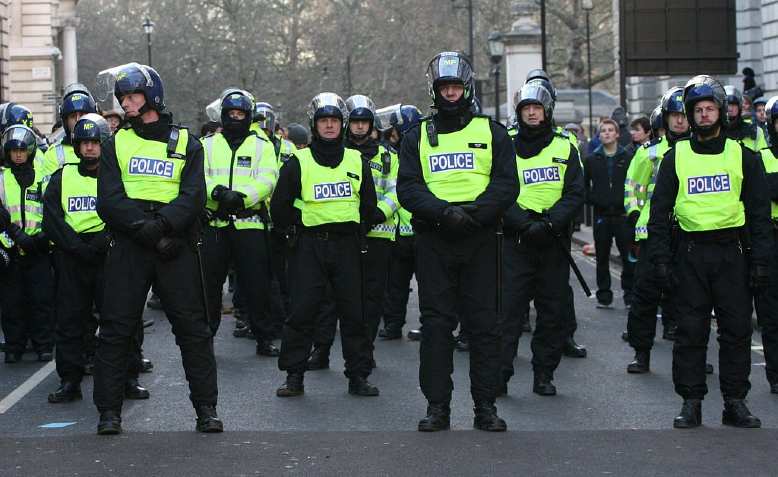 Deep police lines. Photo: Bob Bob on Flickr, license linked at bottom of article
Deep police lines. Photo: Bob Bob on Flickr, license linked at bottom of article
Over 20 years after the Macpherson report was originally published, racism remains endemic in British police forces, argues Terina Hine
It will be of little surprise to many that racial injustice is “deep-rooted and persistent” in the British police force, and that racism in the ranks is not taken seriously by those in charge. Police and governments have done little to stamp out racial injustice in the force, failings remain “systemic” and result in “unjustified inequalities” in both the treatment of the public and BME officers within the service. What may surprise is that these charges come from not from Black Lives Matter protesters or left-wing activists, but from a group of cross-party MPs.
It has been 22 years since the Macpherson report was published, written in response to the racially motivated murder of Stephen Lawrence in south London. The report raised serious concerns over racism and policing and concluded that the investigation into Stephen’s death was “marred by a combination of professional incompetence, institutional racism and a failure of leadership”. It made 70 recommendations.
On Monday the home affairs select committee reported that although there were some initial changes in policing following Macpherson, there has subsequently been a failure to instigate the reforms and there remains “deep-rooted and persistent racial disparities” in British policing. The Macpherson recommendations have been ignored, or not followed through, over the past two decades.
The select committee report exposes racial discrimination in the use of stop and search, in investigations of racist crimes – where victims are treated as suspects – and in the use of new technologies. Discrimination against BME officers is reported as commonplace in recruitment, retention, and disciplinary action – with those from BME backgrounds representing only 7% of the force (reduced to 4% in more senior posts) and being more than twice as likely to be dismissed than white officers. The report castigates the lack of accountability across all 43 police forces and finds a significant and growing confidence gap in how the police are viewed, with black communities having little faith in the service, jeopardising the principle of policing by consent.
According to the report it will take another 20 years for the police to be representative of the communities they serve – one of Macpherson’s key recommendations. It is clear, this is structural racism within the police which goes way beyond instances of individual bias.
A year ago, we witnessed mass BLM protests across the UK. The media and establishment were taken by surprise, with some even asking why such protests would erupt in Britain where policing is by consent and racism is confined to a few bad apples. The discussions that followed tried to put this view to bed; now MPs have echoed the protesters concerns, setting out in black and white the extent of the racial disparity in UK policing. And in a very timely manner.
For as if to prove the point that racism is not only ignored at the top but led from the top Johnson and his Home Secretary Priti Patel launched the government’s new “beating crime” strategy a few days earlier, using questionable language of “fluorescent-jacketed chain gangs” to conjure offensive racial stereotypes, while promoting the most racially discriminatory police power of all: stop and search.
Along with publicly humiliating minor offenders, the plan aims to permanently relax the conditions around stop and search, a policing tactic that is unquestionably racially implemented. In 2020, over a three-month period during the first lockdown, one in four black males aged 15-24, not committing any crime, were stopped and searched. To defend these disparities police claim they target those statistically more likely to be involved in criminal activity – yet black people who are less likely to use illegal drugs are more likely to be victims of drug related stop and search.
According to the select committee report there is no explanation or justification for the nature and scale of the disproportionality in the use of stop and search powers. There is simply no evidence that stop and search works: the Home Office itself reported that “there was no discernible crime-reducing effect” after a large surge in stop and search occurred in London between 2008-11. With black people more than nine and a half times more likely to be stopped than white people, expanding this policy will only antagonise already divided communities, reigniting racial divisions in the process.
The new “beating crime plan” has been widely ridiculed and condemned – the police themselves have called it “weird and gimmicky”. It will do nothing to reduce crime or make communities safer. In reality it is not a strategy but a stunt intended to further the Tory culture war and gain some “tough on crime” headlines to appeal to the blue base. Like many of this government’s announcements there is no substance – it’s just another divide and rule policy.
Although the select committee report demands urgent action to address systemic racism in the police force – the chance of the current Home Secretary implementing such radical change must be lower today than at any time in the 22 years since Macpherson. But even if this report is left to gather dust on the shelves of the parliamentary library, it does provide a serious rebuke to those who deny that racism is endemic in the police and importantly it vindicates the hundreds of thousands who took to the streets last summer in support of Black Lives Matter.

